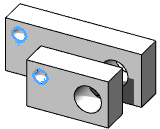| All mate errors |
Use MateXpert for guidance when fixing mate errors. See
MateXpert. |
| Conflicting or redundant over defining mates |
Delete or edit the mate that causes the problem. The best practice is to fix over defined mates when they occur, and not later.
When mates conflict, one approach is to suppress the over defining mates one at a time until the assembly is no longer over defined. This can help you identify the cause of the conflict. Delete or edit the offending mate to resolve the conflict.
See Example: Conflicting Mates.
|
Dangling mates
The mate cannot find one or both of its references. The referenced component may have been suppressed, deleted, or changed so the mate cannot be solved.
|
The most common way to fix these errors is to select a replacement reference. See
Mated Entities PropertyManager.
See also Example: Mates to Dangling Geometry.
|
Design errors such as inaccurate or incorrect geometry or relations
A common problem involves concentric relations of two parts with hole features.
In the example below, the right side holes of the two parts have a concentric relation. When you try to add a second concentric relation to the holes in green on the left, the sketch is over defined because the distance between the holes on one part is not the same as the distance between the corresponding holes on the other part.

|
See Example: Design Errors and Mating.
|
In-context mating conflicts
You deleted an Inplace mate, then added a mate between a part that was created in the context of an assembly and another component.
Such conflicts only happen if the mate conflicts with an existing in context relation. You can create parts in the context of an assembly without referencing other geometry. These types of parts no not cause a conflict if you delete the in place mate.
|
See Example: Conflicts Between Mates and In-context Features.
|
Mating conflicts with sketch relations
|
|